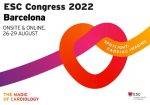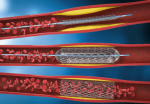The CLASP IID study was a prospective randomized study to assess the efficacy and effectiveness of the PASCAL transcatheter valve repair system compared with the MitraClip device for patients with degenerative mitral regurgitation (MR) at prohibitive surgical risk. The study included Patients at prohibitive surgical risk, candidates for both devices, with MR 3+ to 4+,<a href="https://solaci.org/en/2022/09/21/tct-2022-clasp-ii-d-trial-transcatheter-edge-to-edge-repair-for-mitral-regurgitation-in-patients-at-prohibitive-risk/" title="Read more" >...</a>
Is TCA Useful for Severe Impairment of Left Ventricular Ejection Fraction?
Heart disease is the most frequent cause of heart failure and, in some observational studies, transluminal coronary angioplasty (TCA) could help improve ventricular function. The only major randomized study to compare myocardial revascularization surgery (MRS) vs. medical treatment in patients with ventricular function impairment was the STICH study, which showed no difference at 5 years,<a href="https://solaci.org/en/2022/09/06/is-tca-useful-for-severe-impairment-of-left-ventricular-ejection-fraction/" title="Read more" >...</a>
ESC 2022 | SECURE Trial
This study, presented by Dr. Valentin Fuster, focused on the importance of medical treatment compliance, initially showing data from the FOCUS study where the poor compliance observed in patients after an acute myocardial infarction (AMI) event was improved by creating a polypill (aspirin, simvastatin, and ramipril). Based on this, the SECURE randomized study was conducted<a href="https://solaci.org/en/2022/08/30/esc-2022-secure-trial-3/" title="Read more" >...</a>
The Best of the SOLACI-SOCIME 2022 Main Arena: New Paradigms in Angioplasty
“New Paradigms in Angioplasty,” by Dr. Gregg Stone While most studies on angioplasty in stable coronary artery disease have shown an improvement in angina frequency and exercise capacity, there is no significant reduction in death and acute myocardial infarction (AMI). Currently, one of the main factors is the definition of vulnerable plaque, because it is<a href="https://solaci.org/en/2022/08/10/the-best-of-the-solaci-socime-2022-main-arena-new-paradigms-in-angioplasty/" title="Read more" >...</a>
The Best of the SOLACI-SOCIME 2022 Main Arena: Complex PCI Guided by Intravascular Imaging
In the first session of SOLACI-SOCIME 2022 on “Complex angioplasty guided by intravascular imaging”, Dr. Alejandro Diaz (MEX) reviewed the evidence on intravascular ultrasound (IVUS) in complex angioplasties. A meta-analysis indicated its use is associated with a significant decrease in the risk of death, acute myocardial infarction (AMI), and new target lesion revascularization (TLR) in<a href="https://solaci.org/en/2022/08/09/the-best-of-the-solaci-socime-2022-main-arena-complex-pci-guided-by-intravascular-imaging/" title="Read more" >...</a>
CTO: Trials vs. Real-World
Percutaneous coronary intervention of chronic total occlusions (CTO) is currently indicated for symptom improvement, as studies have inadequate randomization of data which hinders the assessment of hard outcomes. However, patient inclusion in randomized controlled trials has been challenging, especially for highly symptomatic and higher risk patients. This causes a selection bias in randomized studies on<a href="https://solaci.org/en/2022/08/06/cto-trials-vs-real-world/" title="Read more" >...</a>
Are Elevated Lipoprotein (a) Levels Associated with Increased Adverse Events After Peripheral Endovascular Treatment?
Peripheral arterial disease is a manifestation of systemic atherosclerotic disease with increasing prevalence. Moreover, this disease is associated with a high risk of mortality and cardiovascular events. Lipoprotein (a) (Lp a)—which has a proatherogenic, proinflammatory, and antifibrinolytic role—has been shown to be related to major cardiovascular events and peripheral vascular events after acute coronary syndromes<a href="https://solaci.org/en/2022/07/29/are-elevated-lipoprotein-a-levels-associated-with-increased-adverse-events-after-peripheral-endovascular-treatment/" title="Read more" >...</a>
Progress-CTO Score: A Key New Tool to Plan CTO
Intervention of chronic total occlusions (CTO) through angioplasty (PCI) can cause complications, even in highly experienced centers. Plenty has been written on the probability of success for the treatment of CTOs using scores such as CL-SCORE, J-CTO, ORA, E-CTO, CASTLE-CTO, etc. (some of which are usually used when preparing these cases). However, besides estimating success<a href="https://solaci.org/en/2022/07/25/progress-cto-score-a-key-new-tool-to-plan-cto/" title="Read more" >...</a>
Thin vs. Ultrathin Stents: 1-Year Clinical Results After IVUS/OCT-Guided Implantation
Second generation drug-eluting stents have lower frequency of thrombotic complications and in-stent restenosis. While clinical results have significantly improved, having a 2-3% annual rate of these complications within the first year after angioplasty is still worrisome. This resulted in the development of stents with struts <70 µm (ultrathin), with bioresorbable polymer and abluminal cover. Stents<a href="https://solaci.org/en/2022/07/20/thin-vs-ultrathin-stents-1-year-clinical-results-after-ivus-oct-guided-implantation/" title="Read more" >...</a>
Three-Year Outcomes after CTA with 2-Stent Technique Vs. Provisional Stenting for Complex Bifurcation Lesions
The prevalence of coronary lesions with bifurcation involvement is about 20% in patients undergoing coronary angiography (CTA). While provisional stenting is overall the most accepted technique, the 2018 myocardial revascularization guidelines recommend the 2-stent technique for complex bifurcation lesions, defined as side branch with lesion >5mm, distal reference diameter of the side branch ≥2.75, or<a href="https://solaci.org/en/2022/07/13/three-year-outcomes-after-cta-with-2-stent-technique-vs-provisional-stenting-for-complex-bifurcation-lesions/" title="Read more" >...</a>









